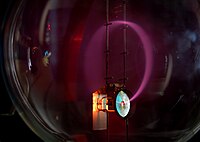Mass-to-charge ratio

Alright kiddo, imagine you have a bunch of toys that all weigh different amounts (mass). But what if you wanted to figure out which toy was the lightest or heaviest? That's where things get tricky because just looking at them won't tell you which one weighs what.
So let's say you have another magical tool - a magnet. You can take your toys and roll them past the magnet to see if they react. This is kind of like what scientists do when they want to figure out the mass-to-charge ratio of a particle.
Particles are tiny, tiny things that we can't see with our eyes like we can with toys. But they do have a mass and a charge, kind of like how toys have a weight and you can tell if they react to a magnet. In the case of particles, they can be charged positively or negatively.
Scientists use a special tool called a mass spectrometer to roll a beam of particles past a magnetic field. The magnetic field will cause the charged particles to move in a curved path, and the amount of curve (or radius) will depend on the mass-to-charge ratio of the particle.
So basically, the mass-to-charge ratio is like a measurement that tells us how heavy a particle is compared to how much charge it has. It's kind of like balancing a seesaw - the heavier the particle, the more it tips the scale. But if the particle has a high charge, it could balance out the weight a bit.
By using mass-to-charge ratio, scientists can identify what kinds of particles they are dealing with and even break down complex mixtures of particles. Kind of like how you can sort your toys by how much they weigh once you have a tool (a magnet) that can help you figure it out.
So let's say you have another magical tool - a magnet. You can take your toys and roll them past the magnet to see if they react. This is kind of like what scientists do when they want to figure out the mass-to-charge ratio of a particle.
Particles are tiny, tiny things that we can't see with our eyes like we can with toys. But they do have a mass and a charge, kind of like how toys have a weight and you can tell if they react to a magnet. In the case of particles, they can be charged positively or negatively.
Scientists use a special tool called a mass spectrometer to roll a beam of particles past a magnetic field. The magnetic field will cause the charged particles to move in a curved path, and the amount of curve (or radius) will depend on the mass-to-charge ratio of the particle.
So basically, the mass-to-charge ratio is like a measurement that tells us how heavy a particle is compared to how much charge it has. It's kind of like balancing a seesaw - the heavier the particle, the more it tips the scale. But if the particle has a high charge, it could balance out the weight a bit.
By using mass-to-charge ratio, scientists can identify what kinds of particles they are dealing with and even break down complex mixtures of particles. Kind of like how you can sort your toys by how much they weigh once you have a tool (a magnet) that can help you figure it out.
Related topics others have asked about:
